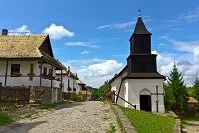Architecture of Hungary

Holloko
The earliest standing architecture in Hungary is in the Roman city of Sopianae (Pecs). Little remains today, but the Christian burial grounds (or necropolis) along with the partial remains of the aqueduct are impressive. Additionally, the Roman city of Aquincum (Budapest) has some standing architecture, although it is less impressive than that in Pecs.
The Romanesque period brought more lasting architecture; the most impressive being the Pannonhalma Archabbey (1000s), which was originally built in the style, but many later additions represent various styles. The Gothic style also made a small impact on the country, with Buda Castle (1200s in Budapest) being perhaps the finest example. However, both the Romanesque and Gothic styles strongly influenced traditional Hungarian architecture in later periods.
The Renaissance brought, like the earlier styles, very little that remains in Hungary today. Some of this architecture was destroyed, while the Turkish invasions delayed or eliminated building in any substantial proportions. The best examples of architecture from this time period, and even into the prior Gothic period can be found on Castle Hill in Budapest.